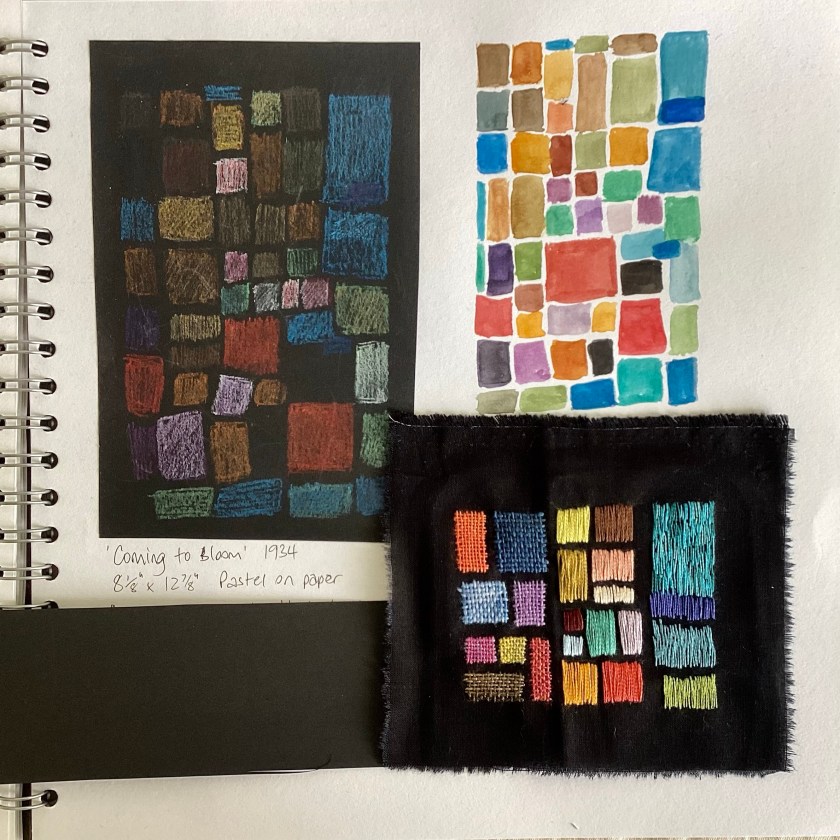
The sketchbook cover is finished – despite all the careful measuring and re-measuring along the way, I am always really surprised when it fits.

I have sketchbooks in various sizes, mostly made from papers that I collate and bind myself. This one is a bought spiral bound 12” square one, which is a good size for exploring mark-making and for holding samples of stitched work.


‘Coming to bloom’ is a pastel drawing made by Klee in 1934, on black paper. I made a quick sketch with pastels, also on black paper – the fixative has dulled the colours a little, so I made a duplicate sketch in watercolour on a white background.
Then the fun really started. I made a little stitched sample on a scrap of black cotton fabric, only about 4” square or so, exploring ways of creating stitched blocks.

I really like the woven blocks. The satin stitch blocks have floats that are too long to be practical, but I also quite like the irregular sketchy effect of the straight stitch sample on the right. I worked the samples from right to left, so the weaving was the last thing I did.

Not quite sure where all this is going, but then some journeys are about exploration and discovery rather than arrival.

A lovely post Karen, well more than that, a fabulous post! Klee is great as a resource and especially so for colour study. I like how you’ve used your different media and then experimented with mark making/stitching. A worthy journey doesn’t meet a destination.
thank you Terry, Klee’s work fascinates me. So much inspiration there for artists in all disciplines but particularly for textile work, I think
it’s fascinating how much more is truly seen when doing exercises like this … and then retained, becoming a part of one’s artistic sensibility
your study of how to render the blocks of color in stitch are fascinating … the weaving is very effective, but I’m partial to the group on the right, and the shorter satin stitch blocks are also quite pleasing … which has me wondering how Jude’s rows of “wrap” stitch might work
Absolutely agree, Liz, I always think the best way to understand something is to draw it. I like the group of long/short stitch too and may well take that further as well as the weaving/darning. I bet Jude’s wrapped stitch would be effective too.
Love the samples. I wonder if Bayeux Stitching the long satin would work. I always fall down when it comes to sampling. 😄
That’s a good idea, thank you 🙂 Yes, I usually bypass the samples stage too. Just looking at a long term plan and I think samples will be useful at this point.
I study native plants ( Pacific Northwest–San Juan Island Washington USA) and herbology—when I really want to know a plant–I always draw and do a little watercolor picture. It really cements it in my soul. I love your idea of knowing Klee better through paint and fiber.
I love the thought of bringing something into your soul by drawing it (drawing it in, perhaps). I’m really enjoying giving myself some time for this.
Love the cover and find all your experiments inspirational. Thanks for sharing!
Thank you for visiting, glad you’re enjoying it 😊
So well envisioned and carried out!
Thank you 😊 I enjoyed making it
This is a good way to explore how the colour changes with the texture, from the pastel darkening with fixative to the changes from satin stitch to long and short to woven stitches. So many new perspectives to draw into your soul!
If only there were more time 🙂